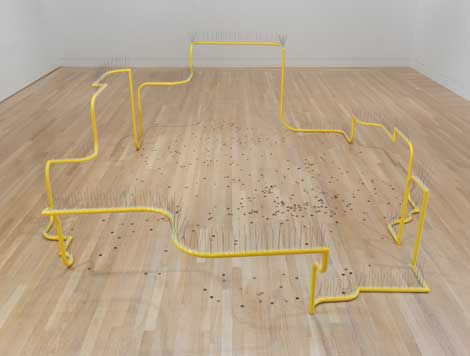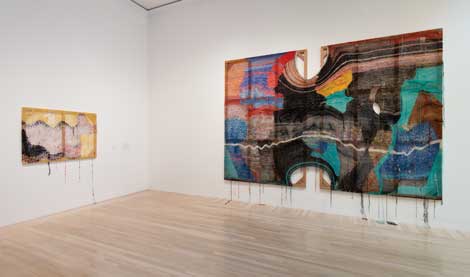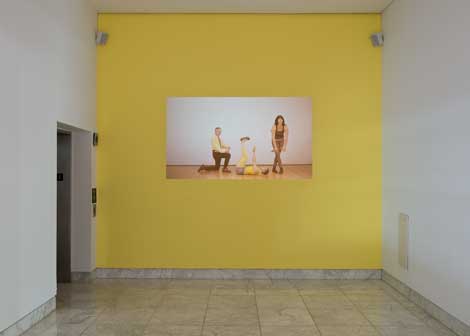Climate experts have yet to advance their science to a point where we might seriously contemplate climate management, but if they ever do, they might find the curatorial method of “Made in L.A. 2014” instructive. This more sharply focused edition of the Hammer Museum’s biennial of Los Angeles artists not only embraces a broadly defined institutional critique, but includes the hypothetical viewer parallel to the trajectories of its subject/artists, giving further scope and dimension to this survey.
Where the first “Made in L.A.” strained for inclusivity, curators Connie Butler and Michael Ned Holte recognize that it is just as important to capture something of the moment. The inclusion of Los Angeles Museum of Art (LAMOA) seems emblematic of both the curators’ self-defined mission for the biennial and a certain mood that marks all of Los Angeles in 2014. At a particularly precarious moment, LAMOA (brainchild of Alice Könitz) embraces a willingness to continually consider new conversations, stake new positions and reframe or redefine others.
“Made in L.A. 2014” has some of the curatorial focus and particularity of its 2001 precursor/predecessor “Snapshot.” There are touchstones with that earlier show here: Lecia Dole-Recio and Katie Grinnan, a not-infrequent collaborator of Könitz’s, were both in that 2001 show. It also represents something more “not a snapshot,” but more of a panoramic establishment shot of what must necessarily compass a diverse terrain and a multiplicity of ideas, currents, sensibilities and strategies.
Holte’s Artforum criticism of the 2012 biennial for its latent “boosterism”—questioning whether the exhibited artists or the exhibition as a whole might represent something particularly indigenous to Los Angeles—was on point. Nor, as Holte acknowledges in his catalog essay, has that changed. The current edition includes artists from at least 10 foreign countries; and one imagines that much of this art could have been produced in several other cities. In its suburban sprawl, Los Angeles has an extraordinary diversity of (sub)urban character, all bearing highly variable moods and moments. Holte makes reference to LA’s “microclimates” in his essay, and the installation itself—sprawling and entirely taking over the museum’s galleries—seems to transition from one microclimate to the next.
As essential as the LAMOA installation seemed to grounding this exhibition, other collaborative/collective installations came up short. After passing the Public Fiction and KCHUNG installations, as well as Clarissa Tossin’s grim academic (but high carbon footprint) exercise, visitors might have steeled themselves for a grim biennial, but if they lingered before a monitor on the landing just before entering the museum courtyard, they would have encountered Emily Mast’s ENDE (Like A New Beginning), one of the most formally successful presentations of the biennial.
In a beautifully choreographed and staged sequence of actions, exchanges, gestures, epiphanal moments and reveals, ENDE explores notions of transition and transposition; also the variable fragility, durability and instability of memory, transference and transfiguration. Props and elements from the performances are discreetly installed throughout the museum—transitional touchstones or totems between galleries.
The soft pink-and-blue glow of Samara Golden’s installation, “Thank You,” in the first gallery heightened a certain pop-up boutique atmosphere, with its mirrors, music, decorative textiles, accessories and waxed jeans propped under ginger jar lamps. Here, too, there was a transpositional, multiplicative element of time and space; also the sense of its mapping, flattening (flat paper digital watches wrapped around the lamps) or dissolution and further extension into the hyperreality of the digital domain.
Having effectively been enlisted as an agent in this mapping, the viewer was sent tumbling like Alice through something not unlike the spikes, peaks and valleys exemplified by Gabriel Kuri’s “Donation Fountain” (in a kind of acid-yellow coated steel—no water, no birds in sight; just coins), and a not-so-mad “tea party” hosted by Harry Dodge, whose multimedia installation of objects, drawings and digital media clearly owed something to iconic LA artists like Baldessari, McCarthy and Pettibon, but also had enormous resonance with work in adjacent galleries (and across the courtyard).
On the other side of the museum, the multidimensional character of Golden’s “Thank You” took abstract and chromatic shape in Channing Hansen’s hand-knitted (and often spun and dyed) constructions. They are mounted as if they were paintings, which is what Hansen calls them. The word to describe their painterly qualities doesn’t quite exist yet—in part because those qualities are pre-designed digitally by computer algorithms based on mappings of nth-plus dimensional polytopic geometric constructions. The palettes are similarly complicated by the undulations and irregularities of complexly knitted and custom-dyed yarns. But they are dazzling in their warps, waves, whorls, stripes, puckerings and “drips” of vibrantly colored yarn. There are passages in these paintings evocative of Monet, Barnett Newman and Howard Hodgkin, although they defy comparison in their construction.
Tala Madani seems to occupy a nether space or “nth dimension” (while we’re on the subject of polytopic spaces or mappings) among the microclimates of LA art production. The work might come from almost anywhere, but had a presence here that could knock a viewer sideways, confronted by both large boldly graphic—simultaneously abstract and representational—paintings, and drawn back to crudely abstracted stop-motion animations playing on screens diagonally opposite. In the paintings, a little girl leans back on her haunches, skirt lifted slightly over her knees, exposing an (abstracted) vulva. “3D Pussy” is essentially two slightly offset renderings in neon red and bright green with the green laid on top. Madani’s method is probably similar for the stop-motion animations, but the style is more fluid, fleshing out the animated figures. Madani’s generically simian-looking male figures variously sulk, squat, lunge at, attack and torture each other (and themselves) until, coming full fluid circle, rendered bloody or dead. The flatness and fluidity belie the work’s frank commentary on painting, play and power.
There were some misses along the way. Intent on driving home her dubious cultural interrogations, Danielle Dean (“Training”) managed to raise a few other questions for the viewer, such as, “Okay, if ‘This Is Not a T-Shirt’—then what is it?” (and “why am I hating it?”). Then there were works skirting the fringes of novelty, curiosity or outsider art, yet failing to fully engage their sources, stopping short of a larger inquiry, an extension of the moment; or simply content to be enveloped in artifice.
Yet there are “microclimates” amongst the community of Los Angeles artists that enable these novelties. I appreciated that within this panoramic “shot,” there was room for the idiosyncratic (or simply “disappeared”—e.g., Tony Greene). Similarly—going back to LAMOA’s example—there are the conversations that occur among seemingly disparate artists and their art (e.g., placing a group of Ricky Swallows in the same room with Lecia Dole-Recio, creating a dynamic conversation around notions of cut, collage and material).
There’s a maturity and subtlety to this edition of “Made in L.A.” LA is finally growing up (as opposed to simply growing “out”); yet it is more chaotic and compromised than ever. We would need the panoramic shot the curators have composed here for the simple reason that the production demands it. But the curators have also captured something of that paradox—itself (pacing Hansen’s chromatic chaos) in constant flux. The artistic and cultural “microclimates,” are subject to change no less than their physical counterparts within the larger cultural climate change. There’s no predicting what dimensions such “weather systems” may unfold, and for this extended glimpse into its liminal thermodynamic zones, a viewer might just say “thank you.”
All images: Installation views at the Hammer Museum, Los Angeles.
June 15–September 7, 2014. Photo by Brian Forrest.






